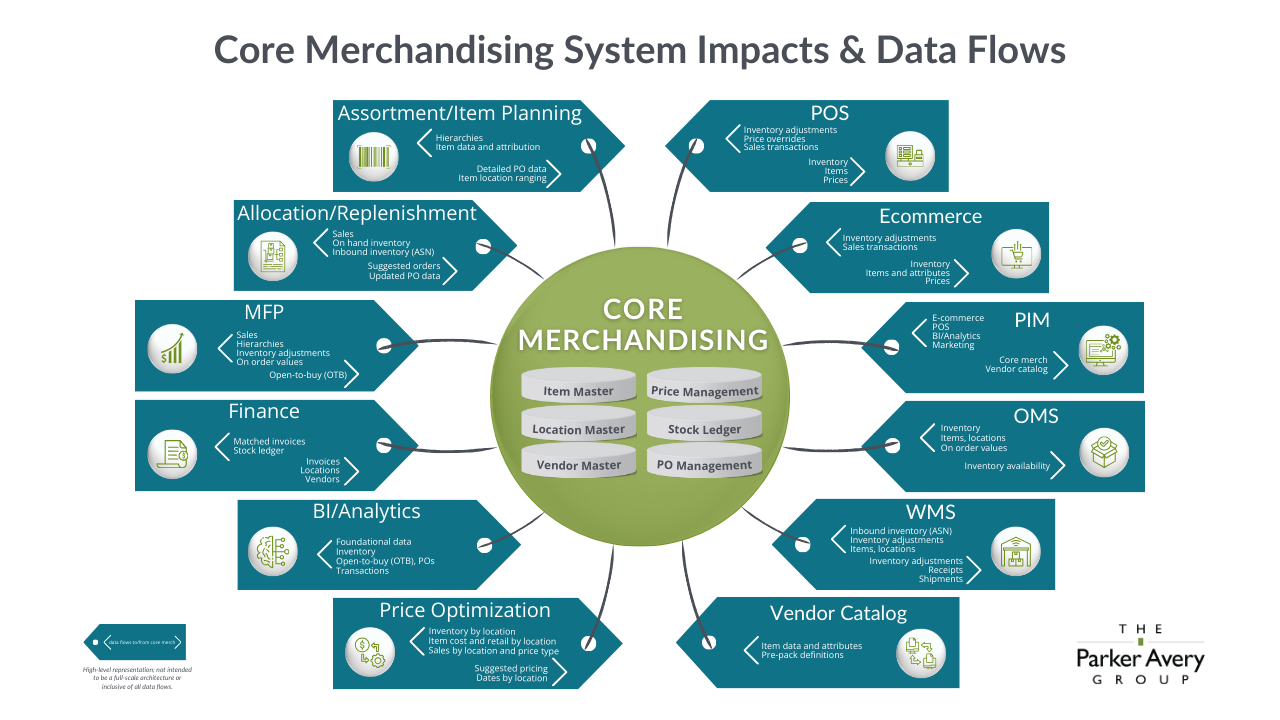The Expert Guide to Core Merchandising
In the ever-evolving landscape of retail, staying at the forefront of industry trends and innovations is paramount to success. While it would be a far cry to consider core merchandising as trendy or innovative, an effective core merchandising environment is necessary to enable essentially every other retail capability. Core merchandising is a very broad topic under which many different functions fall, but at a high level, it represents the foundation or backbone of all retail systems.
Further, the outputs from core merchandising systems are critical to achieving the expected benefits of implementing modern retail systems. As such, understanding the scope and impacts of core merchandising is vital to retail decision-makers.
In this comprehensive expert guide, we delve deep into core merchandising, providing invaluable insights and strategies based on decades of Parker Avery industry and consulting experience. We explore the scope and intricacies of core merchandising, define key capabilities, outline common challenges, and offer actionable advice that will empower retailers to make informed decisions related to core merchandising and other strategic retail initiatives.
What is core merchandising?
When we discuss core merchandising, we are typically speaking of a suite of software applications used by retailers to manage their products (items), locations, suppliers, inventory, pricing, and promotions. It serves as a central hub for various merchandising, financial, and operational activities within a retail organization.
In an ideal environment, core merchandising systems provide a common foundational data source for other retail systems, such as demand forecasting, planning, replenishment, allocation, warehouse management, and finance. Much of a retailer’s product-related data is contained and managed in the core merchandising system, enabling buying, planning, financial and operational business decisions to be made. Core merchandising systems primarily support saleable products, but some systems provide basic functionality for non-saleable items (e.g., fixtures and supplies). Core merchandising systems also allow retailers to structure their data into efficient product and location hierarchies.
The major components in a typical core merchandising system include:
These six major components accumulate what is known as the ‘foundation data’ or data of record. This data supports the following functions (plus many more):
- Inventory management
- Item location eligibility
- Pricing execution
- Supplier invoicing and payments
- Item/vendor/location status (active vs. inactive)
- Allocation and replenishment
- Reporting
Foundation data is the source for downstream planning, financial, and operational business decisions.
What core merchandising capabilities are the most important?
- Data structure and governance
Data structure and governance are critical to enabling downstream retail business capabilities. As an example, if not set up properly, an item may not appear correctly (or at all) in a store’s POS system. This issue usually leads to manual and human error at the store level, resulting in shrink and bottom-line impacts.
Further, some states and localities have very specific laws around what and how products can be shipped into the state, and the data structure and correct attribution need to address those nuances. For example, many states have restrictions on shipping alcoholic beverages, furs, certain plant species, and nicotine products. There are also some obscure requirements. As an example, if a retailer ships a lamp to California, it must also ship a light bulb. These attributes are managed in the core merchandising system and prevent allocation or replenishment systems from sending products where they should not be shipped.
Having a solid and effective data governance strategy is critical to all retailers and is not isolated to core merchandising. A significant number of system implementation project issues are the result of poor and inaccurate data or poorly structured data. Based on Parker Avery’s system implementation experience, about 50% of projects require significant upfront work on clients’ data to drive successful outcomes. These activities are typically around reclassifications, hierarchy changes, and overall data cleanliness.
Proper and efficient integration
Proper and efficient integration from core merchandising to downstream systems is one of the key benefits that retailers may be able to quantify. Companies without a solid core merchandising system in place typically have IT resources dedicated to managing data and supporting interfaces needed to drive assortment planning, allocation, replenishment, and other systems. These resources are not only expensive but also sometimes possess rare technical knowledge that is critical for supporting legacy interfaces. The increasing scarcity of skills to maintain older systems (e.g., FORTRAN coding) also represents a significant risk to the company.
Real-time inventory movements
To meet changing consumer demands and support services such as curbside pick-up or the ability to display in-stock availability in support of omnichannel orders, retailers need to have access to real (or near-real) time inventory. This can be managed by setting minimum thresholds of availability (e.g., if fewer than three units are on-hand, the item is displayed as out of stock) or enabling mid-day updates to inventory levels.
Effective capture and management of real-time inventory requires that transactional systems (in-store, e-commerce, and even WMS) can send information throughout the day (e.g., “trickle pull”) and for the core merchandising system to receive and update the information. Because this process is typically not audited, there will need to be a true-up at regular periods to ensure that the on-hands are as accurate as possible.
Core merchandising system impacts and data flows
To fully comprehend the above key capabilities, it is important to understand the myriad of retail systems that a core merchandising environment impacts. The following infographic is a high-level representation of these data flows and connected systems but is not intended to be all-encompassing or a full application architecture. It is a starting point for conversations about how well a retailer’s core merchandising environment supports (or inhibits) downstream systems and opportunities for improvement.

You may also like
What common mistakes or challenges exist?
Replicating the past
Many retailers have spent years customizing their current foundational systems (whether home-built or an antiquated, packaged solution), forcing them to maintain and manage information that is typically not part of modern systems. This often represents an unnecessary overhead cost.
Existing legacy core merchandising environments are also characterized by highly manual processes needed to maintain data and integration to downstream systems. The familiarity and attachment with a “tried and true” legacy system environment—regardless of how broken and inefficient it may be—often hampers a company’s ability to modernize and adopt new ways of working.
Both the business and technical teams must take a deep and honest look at their current core merchandising flaws and inefficiencies, and outline specific benefits expected from migrating to a desired future state. This assessment should also include benefits that will translate beyond core merchandising.
- The Frankenstein approach
Many companies do not have the appetite for the time and investment required to implement a core merchandising system properly. These retailers often attempt to piecemeal existing disparate systems together. However, this Frankenstein approach results in significant challenges when trying to implement newer technologies that rely on sound data structure to perform well and support desired capabilities. This approach also forces many retailers to maintain and manage duplicative information across multiple systems that often have varying degrees of functional sophistication. Two significant issues result:
- Data errors due to the required human intervention and the inability of many legacy systems to properly integrate.
- Incapability to effectively take advantage of advanced functionality because two systems are incongruent.
Many legacy POS systems cannot handle advanced pricing and promotion strategies that are supported in the price execution capabilities of a modern core merchandising system (and vice versa).
Further, we have seen instances where companies have embarked on multiple intermediary IT projects to accommodate the lack of a solid core merchandising system. In taking this approach, some retailers end up spending the same (if not more) money or time on these smaller projects than they would have on selecting and implementing a modern core merchandising system. Further, the result is still multiple systems, typically higher support costs and risks, plus less flexibility.
Skipping stock ledger
Many companies do not realize that having a stock ledger in core merchandising ties in more seamlessly with the transactional data which then feeds data from merchandising and planning systems into the financial ledger. When implemented well, core merchandising systems can tie a retailer’s systems together for a much more cohesive, consistent, and strategic use of data. Retailers that do not have good stock ledgers (or stock ledgers at all) usually struggle with data issues, requiring extreme manual manipulation to bridge the disconnect between merchandising, planning, and finance operations. This disconnect typically results in confusion about how the company reports or understands operations, sales, and measurements.
Extra layers in the hierarchy only make the overall experience throughout all systems more difficult to navigate and manage.
Overcomplicating the hierarchy
Some retailers overcomplicate the product hierarchy with too much detail. Rather than including it in the hierarchy, this detail should be supported by product attributes or enhanced by other systems, for example, a product information system (PIM) or even an e-commerce platform. Extra layers in the hierarchy only make the overall experience throughout all systems more difficult to navigate and manage. A good rule of thumb is to only include characteristics that are financially planned and reported against in the product hierarchy and are expected to exist for multiple years. This also helps with setting targets. The hierarchy should be kept as simple as possible and yet impactful to business decisions.
Expecting a direct ROI
Core merchandising is sometimes overlooked because it is not considered an innovative technology. Further, there is no direct, quantitative ROI attached to a core merchandising system implementation. However, like an effective data governance strategy, a modern core merchandising system enables many other capabilities to generate the expected ROI. As an example, assortment planning is very difficult without a solid item master; further, doing an assortment plan well is nearly impossible without the proper attributes associated with those items. This data all resides and is managed in the core merchandising system.
To compensate for the lack of near-immediate benefits, we have seen clients assess whether they can advance certain functions or focus on different capabilities to gain efficiencies or improve financial impacts (e.g., pricing, size/pack optimization, replenishment). While this morphed Frankenstein approach may look good on an initial roadmap from a capabilities impact perspective, it will lead to either rework in the future (namely data integration) or further dependency on an outdated core merchandising platform.
Rushing the implementation
Some companies try to rush a core merchandising implementation. The upfront assessment required of all the downstream systems, capabilities, and data requirements takes time, even before the system is designed, configured, tested, trained, and rolled out. A typical core merchandising implementation can take anywhere from nine to eighteen months depending on the level of complexity and points of integration. With ROI difficult to quantify, as mentioned earlier, the long timeframe and expense are often hard for retailers to swallow. However, as the key foundational layer upon which essentially every other retail system will rely, a successful core merchandising system implementation cannot be a quick project.
A typical core merchandising implementation can take anywhere from nine to eighteen months.
- Lack of business support and change management
Many large global retailers have been operating with a myriad of legacy foundational systems for decades, and the implementation of a core merchandising system represents an enormous change to business processes, as associates tend to be comfortable with what they know. Changing data structures and hierarchies, employing new data management processes, and adding data governance will fundamentally change how people work and interact. As such, strong organizational representation from impacted business teams, executive support, and change management are critical. User concerns, issues, and expectations must be heard, understood, and carefully managed. Further, ample internal and external communication beginning early in the project and throughout is key to success.
What is required for a successful core merchandising environment?
Retailers who manage core merchandising well consider their end-to-end process. This is one of the more difficult system layers to implement because it is important to get it right, due to the myriad of downstream system and business process impacts. A well-orchestrated core merchandising environment requires strategically answering key questions such as:
Core Merchandising Considerations
- What do we currently lack to make better, faster business decisions?
- Do we know our near real-time inventory to be able to determine how best to distribute products via allocation and replenishment?
- How are the execution activities separated from reporting activities to reduce noise in foundation structures?
- What downstream system functionality is not supported by our core merchandising system (but should be)?
- How should our products and locations be structured to get the most reliable results from analytics?
- How often do we perform reclass and how painful is it?
- How quickly can we get new acquisitions or new banners consistent or on board with our existing platform?
Companies that have a solid core merchandising system have thoroughly evaluated all their downstream solutions and capabilities that need data, as well as the existing (or potential) data structures. This type of end-to-end assessment must be done prior to implementation and needs to include all competing data types as well as the levels of consumption because all those systems will consume data in very different ways.
Very related to considering the end-to-end process is making data integrity a priority. Companies that excel with core merchandising have well-structured data governance programs and dedicated data stewards in place. Data governance ensures any changes to the foundational data layer are planned, structured, reviewed, and approved. This approach helps ensure all the work to get the data in shape for core merchandising and all the other systems is not done in vain. It further helps the data remain as clean and properly managed for the business as possible.
While data governance helps maintain structure and cleanliness within core merchandising, it is the system itself that enables nimbleness to accommodate business changes such as new channels, fulfillment methods, or geographies.
You may also like
What innovations can improve a company’s core merchandising capabilities?
Utilizing integrated technologies like vendor catalogs, product lifecycle management (PLM) systems, and product information management (PIM) systems reduces data management workload and ensures data quality stays high. Many national brands now provide the ability to import product data along with attributes from an online vendor catalog directly into core merchandising systems. Further, many solutions have induction capabilities so data from spreadsheets can be uploaded into a retailer’s core merchandising environment. Many of these tools were not available even 10 years ago. By leveraging these methods, organizations can expect up to an 80% reduction in the manual effort required for master data setup.
Final Word
A core merchandising system and related business processes play a key role in managing a retailer’s product offerings, pricing, and inventory levels. Further, when implemented strategically, modern core merchandising systems can deliver efficiencies in the workloads associated with data setup and maintenance, reductions in IT support costs and risks, and significantly diminished negative impacts associated with data errors.
While many retailers struggle with investing in core merchandising systems, as the implementation rarely (if ever) produces a direct ROI, the indirect benefits can be substantial. These indirect impacts are primarily around easier and faster implementation of downstream systems (such as allocation, replenishment, advanced analytics, and price optimization), as well as greater realization of expected business results.
You may also like






